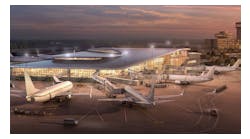Opinion: As ‘Summer of Hell’ Ends at IAH, Here’s the Latest on Houston Airport Construction and Growth Plans
Aug. 29—Resurgent demand for travel — "revenge travel" as it's been called — spurred a tumultuous summer for America's airports as millions of passengers ran into short-staffed airlines, canceled flights and frequent delays, all while paying premium prices for tickets.
But then, officials with the Houston Airport System — which includes George Bush Intercontinental, Hobby, and Ellington Airports — are used to tough days at the office. Houston Airport System Director Mario Diaz, for example, was deputy general manager at Hartsfield-Jackson Atlanta International Airport during the Sept. 11 terrorist attacks, which shut down air traffic for days.
The airport system's chief operating officer, Jim Szczesniak, who arrived in Houston in February, was the airport director for the Ted Stevens Anchorage International Airport in Alaska when the coronavirus pandemic began. A cargo plane carrying 201 U.S. State Department officials leaving Wuhan province after China began lockdowns touched down at the airport in January 2020, the first flight of COVID evacuees to land in the United States.
The events of the summer of 2022 were nowhere near as dramatic, but Houston's airports and its passengers not only faced the difficulties of an overtaxed air transport system, but also major construction at Bush Intercontinental that tied up traffic and only added to the aggravation of flying.
Diaz and Szczesniak recently sat down with the Houston Chronicle to discuss the so-called "summer of hell" for air travelers, the future of Houston's airports, and the challenges of expanding and modernizing.
"One of the things that we've learned is we can no longer make any improvements at the airports on the margin, at the edges," Diaz said. "We have really got to go in, we've got to disrupt these terminals."
Uncooped
Air travel fell off the cliff at the outset of the pandemic, and industry analysts projected it wouldn't recover until 2024 or 2025. That's still the expectation, as COVID-19 travel restrictions remain in many countries, and business travel has recovered more slowly than leisure travel. Globally, air traffic was at 70.8 percent of pre-pandemic levels in June, according to the International Air Transport Association.
But some segments have come back. Domestic, European and Latin American travel through Houston's airports are about 90 percent of 2019 levels, Diaz and Szczesniak said. Travel to Mexico has been especially strong. Earlier this year, travel to Mexico from Houston was running at 105 percent above 2019 levels.
"Everybody was going to Mexico," Diaz said. "People just wanted to get out."
But other international routes are lagging. Travel to Asia, for example, is only at 31 percent of pre-pandemic levels, Szczesniak said. But, he added, "We are seeing incremental gains on the horizon — Air New Zealand's back. We are going to be starting with our Sydney flights back. We are starting to see that recovery."
The recovery in passengers, however, has run up against labor shortages and reduced schedules, resulting in packed planes and fewer options for travelers — particularly when flights get canceled. Cancellations are up this year, many of them due to lack for crews to staff the planes.
Between Memorial Day weekend and mid-August, more than 2 percent of 2.1 million scheduled flights across the country were cancelled, according to FlightAware, a flight-tracking service. And nearly a quarter of completed flights experienced significant delays.
Given staffing shortages, Diaz said it made sense for airlines to reduce schedules and avoid even more cancellations. For Houston airports, Diaz said, fewer flights weren't all bad because they helped ease congestion on the roadways leading to and from Bush Intercontinental.
"We're having some growing pains here," he said.
Summer nightmares
In some respects, Houstonians had it easy during this summer travel season. The rate of cancellations at local airports this summer were about half the national rate, according to FlightAware.
But for many Houstonians, getting to the terminals at Bush Intercontinental was more harrowing tha finding overhead luggage space on packed planes. Major projects engulfed Terminals C, D, and E in construction and generated long traffic backups.
Airport officials had hoped that much of this work could be completed before air travel began to rebound from the pandemic, but the pent-up demand proved stronger than analysts had expected.
"We were caught flat-footed," Diaz acknowledged.
The $1.4 billion IAH Terminal Redevelopment Program which has been under construction since 2019, was bound to create some disruption, given its scope.
It calls for a new international terminal as part of an overhaul of an international terminal complex that will accommodate more than 15 foreign-flag carriers and United Airlines' international service. International travel through Bush Intercontinental's aging Terminal D has nearly quadrupled since 1990, according to Houston Airport System.
A key requirement for international travel, Diaz explained, is access to gates that can accomodate wide-body aircraft, such as the Boeing 777. As it stands, IAH has only fourteen such gates at Terminals D and E, which handle international arrivals and departures.
"That's it," he said. "That's all we have, for an airport the size of IAH, in a (metro area) of 7.3 million people, with a growing economy, growing workforce, in-migration of a lot of people on a daily and annual basis."
Of course, he continued, it's more than just adding a dozen gates. The terminal redevelopment program calls for a new security checkpoint with 17 lanes, more capacious International Arrivals hall, a new pier; a new processing facility and refurbishments throughout.
"The system consists of not just gates," Diaz said. "It consists of roadways. It consists of parking. It consists of curb space. It consists of ticketing counters. It consists of security checkpoints. They've all got to work together as a system in order to process passengers smoothly through."
"We have a piece of infrastructure that was planned in the 1960s," Szczesniak said. "We've continued to add and add and add, and that just kind of caught up to us."
Diaz and Szczesniak say that they've considered many ideas to ease congestion while work is underway, but found some impractical. For example, shuttle buses could in theory ferry passengers from remote locations to Terminals C, D, and E, but with limited curbside space, those buses would also get stuck in traffic.
"The problem with those solutions — and we've modeled this — is that they don't work," said Diaz.
Congestion has eased as parts of the project were completed. In June, for example, elevators in Terminal E reopened, allowing passengers arriving to use the underground train to make connections in other terminals, rather than waiting for shuttle buses along a painfully crowded curbside.
Several roadways have been reopened, improving traffic flow, and all lanes on South Terminal Road are on track to reopen by Thanksgiving, when United Airlines finishes work on its early bag storage building.
The entire project is still scheduled for completion in 2024, Diaz said.
Future growth
While the IAH Terminal Redevelopment Program is obviously the biggest project at Houston's airports, Hobby and Ellington are also planning for growth, Diaz and Szczesniak said.
Southwest Airlines has embarked on a $250 million terminal expansion at Hobby, with plans to construct seven new gates at that airport's west concourse. Diaz expects to seek Houston City Council's approval of the plans in November.
The Houston Spaceport, co-located at Ellington Airport, has already welcomed three anchor tenants—Collins Aerospace, Intuitive Machines, and Axiom Space—as city leaders aim to develop a space cluster in Houston.
All of these plans, Diaz and Szczesniak, are rooted in expectations that the city and region will continue to grow — and so will its airports. With all growth, however, come growing painsm as anyone trying to navigate the construction at Bush could tell you.
"It's going to be a phenomenal terminal, when it's finished. It's going to be one of a kind. It's gonna be really high grade in the United States," Diaz said. "But getting there is the problem."
But it's going to be worth it, said Szczesniak
"This airport system delivers roughly $36 billion in annual economic activity for the Houston region. It's responsible for roughly 190,000 jobs," Szczesniaksaid. "You can see how important it is to make sure that we invest in this economic engine that we've got here."
___
(c)2022 the Houston Chronicle
Visit the Houston Chronicle at www.chron.com
Distributed by Tribune Content Agency, LLC.


